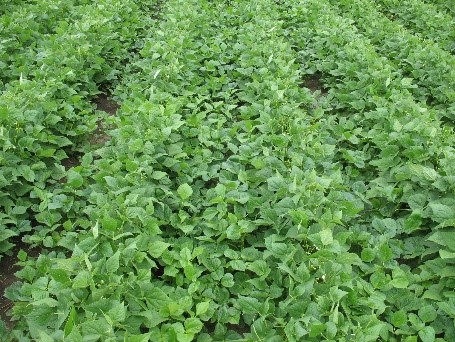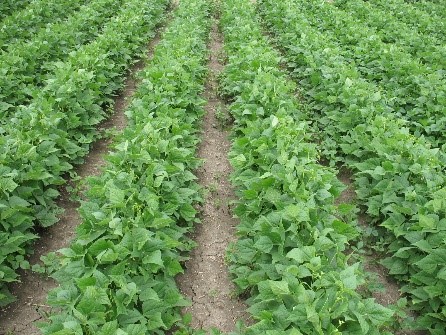Introduction
Azuki beans have been grown in Ontario for over two decades with an estimated 20,000 acres being grown in 2020. Acreage has continued to climb as the profitability of growing azuki beans is very attractive to growers. A better understanding of agronomic practices to produce azuki beans has spurred on growth in this niche market.
Azuki bean production does not come without its challenges. One of the biggest challenges facing producers is the ability of azuki beans, lost in the harvesting process, to remain viable in the soil for many years after. This poses a problem in subsequent crops. Volunteer azuki beans compete with following crops for resources and can negatively impact yield. If left uncontrolled, these volunteer azuki beans will produce seed that will return to the soil seedbank. Of concern is the possible contamination of crops such as IP soybean and dry common beans. Separating volunteer azuki beans from the crop can be quite costly to the producer as well as the processor. Volunteer azuki beans have proven difficult to control in IP soybean and dry common bean.
Evaluations
In 2015, trials were initiated at the Huron Research Station to study volunteer azuki bean control at different application timings in white beans using Permit herbicide. Permit was selected because of its crop safety in white beans and because previous tolerance trials demonstrated that azuki beans were susceptible to postemergence applications of Permit. Azuki bean seed was broadcast over the entire trial area and worked in the day of white bean planting. Initial trials evaluated Permit at 19 g/ac across three application timings: preemergence, early postemergence(V1) and late post-emergence (V3). In 2017 further studies were initiated to evaluate Permit at three postemergence application timings; applications were made at V1-V3 (early), V3-V4 (mid) and V4-V9 (late) stage of volunteer azuki bean at three rates (14 g/ac, 19 g/ac and 27 g/ac) to determine what timing and rate would be most beneficial. Evaluations included control ratings, volunteer azuki bean density and biomass assessments, percent contamination of white bean crop with volunteer azuki bean and yield.
Results
Initial studies demonstrated that Permit applied preemergence provided little to no control of volunteer azuki bean with no significant reduction in density, biomass or percent contamination. Postemergence applications provided poor to fair control of volunteer azuki beans with no reduction in plant density. There was a reduction in percent contamination and an increase in yield with the early postemergence application.
The second set of trials which evaluated three application timings and three rates found that control at 8 weeks after application was poor with no significant reduction of volunteer azuki bean density. In general, volunteer azuki biomass was reduced at all three rates across all three timings. Of interest is the reduction in percent contamination when Permit was applied at the V1-V3 stage and the V4-V9 stage timing of application at 19 and 27 g/ac.
These results prompted further analysis of the data to determine the ideal Permit rate and application timing to minimize crop contamination with volunteer azuki bean. It was clear that Permit would not necessarily provide control of volunteer azuki bean but it may delay azuki bean development and seed production enough to reduce contamination in white bean.
White bean contamination with azuki bean varied with Permit application timing and rate. Permit applied at 14 g/ac reduced azuki bean contamination in white bean by an average of 42%, however the range was from 7 to 98%. The reduction in azuki bean contamination increased to 75% when the rate of Permit was increased to 19 g/ha, the range in contamination was 6 to 98%; the best application timing was at the V1-V3 stage. Increasing the rate of Permit to 27 g/ha resulted in a 70% reduction in contamination with a narrower range of 34 to 98%; the best application timing was the V1 to V3 stage.
The chart below summarizes the impact of Permit on azuki bean contamination in white bean as influenced by rate and application timing. The data indicates that Permit should be applied at 19 to 27 g/ac targeting the V1 to V3 stage of volunteer azuki bean. In the event that application cannot be made during the V1 to V3 stage growers will want to consider using the 27 g/ac rate at the V4 to V9 stage of azuki bean as their next best option.
Table 1. Rate and timing of application of Permit herbicide to minimize volunteer azuki bean contamination in white bean.
| % Contamination | |||||
| Rate | Untreated | V1-V3 | V3-V4 | V4-V9 | Average across Timing by Rate |
| Permit – 14 g/ac | 31 | 19 | 18 | 18 | 18 |
| Permit – 19 g/ac | 31 | 8 | 13 | 14 | 11 |
| Permit – 27 g/ac | 31 | 9 | 15 | 10 | 12 |
| Avg. across Rates X Timing | 31 | 12 | 15 | 14 | |


Conclusions
Permit applied postemergence does not provide consistent control of volunteer azuki beans in white beans. However, growers can use Permit strategically to reduce volunteer azuki bean contamination in their crop sample and to reduce volunteer azuki bean seed return to the soil seedbank.
Growers should target applications at the V1 to V3 stage of volunteer azuki beans at rates of 19 to 27 g/ac. Where application has been delayed beyond V3 it is recommended that growers consider targeting the V4 to V9 stage of azuki bean at 27 g/ac. Permit has excellent crop tolerance in white bean at all rates evaluated in these studies.
For further information please contact Peter Sikkema (psikkema@uoguelph.ca) or Todd Cowan (tcowan@uoguelph.ca)
This article was written by Todd Cowan and Peter Sikkema.